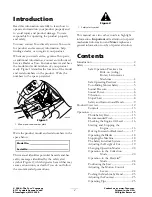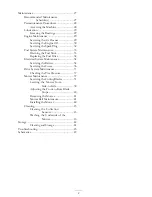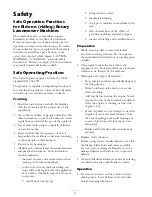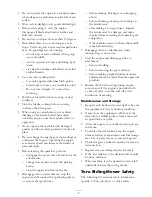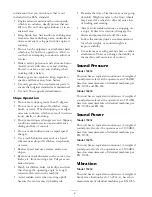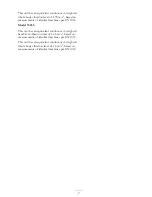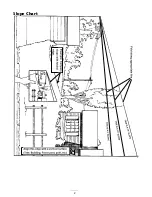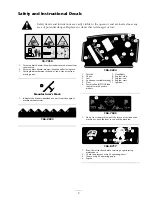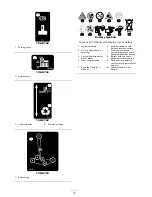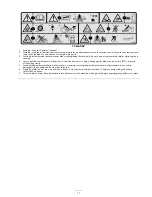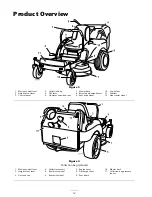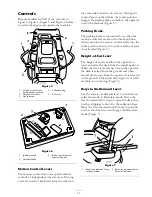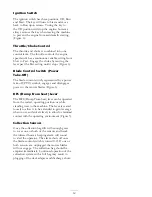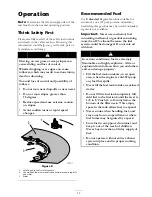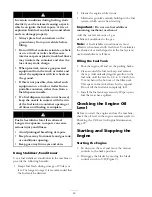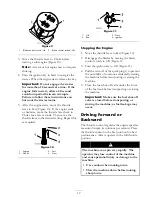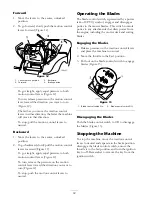
•
Do not operate the engine in a confined space
where dangerous carbon monoxide fumes can
collect.
•
Mow only in daylight or in good artificial light.
•
Before attempting to start the engine,
disengage all blade attachment clutches and
shift into neutral.
•
Do not use on slopes of more than 15 degrees.
•
Remember there is no such thing as a safe
slope. Travel on grass slopes requires particular
care. To guard against overturning:
– do not stop or start suddenly when going
up or downhill;
– use low speeds on slopes and during tight
turns;
– stay alert for humps and hollows and other
hidden hazards;
•
Use care when pulling loads.
– Use only approved drawbar hitch points.
– Limit loads to those you can safely control.
– Do not turn sharply. Use care when
reversing.
•
Watch out for traffic when crossing or near
roadways.
•
Stop the blades rotating before crossing
surfaces other than grass.
•
When using any attachments, never direct
discharge of material toward bystanders
nor allow anyone near the machine while in
operation.
•
Never operate the machine with damaged
guards or without safety protective devices in
place.
•
Do not change the engine governor settings or
overspeed the engine. Operating the engine
at excessive speed can increase the hazard of
personal injury.
•
Before leaving the operator’s position:
– disengage the power take-off and lower the
attachments;
– change into neutral and set the parking
brake;
– stop the engine and remove the key.
•
Disengage drive to attachments, stop the
engine, and disconnect the spark plug wire(s)
or remove the ignition key
– before clearing blockages or unclogging
chute;
– before checking, cleaning or working on
the lawnmower;
– after striking a foreign object. Inspect
the lawnmower for damage and make
repairs before restarting and operating the
equipment;
– if the machine starts to vibrate abnormally
(check immediately).
•
Disengage drive to attachments when
transporting or not in use.
•
Stop the engine and disengage drive to
attachment
– before refuelling;
– before removing the grass catcher;
– before making height adjustment unless
adjustment can be made from the operator’s
position.
•
Reduce the throttle setting during engine
run-out and, if the engine is provided with
a shut-off valve, turn the fuel off at the
conclusion of mowing.
Maintenance and Storage
•
Keep all nuts, bolts and screws tight to be sure
the equipment is in safe working condition.
•
Never store the equipment with fuel in the
tank inside a building where fumes can reach
an open flame or spark.
•
Allow the engine to cool before storing in any
enclosure.
•
To reduce the fire hazard, keep the engine,
silencer, battery compartment and fuel storage
area free of grass, leaves, or excessive grease.
•
Check the grass catcher frequently for wear or
deterioration.
•
Replace worn or damaged parts for safety.
•
If the fuel tank has to be drained, this should
be done outdoors.
•
When machine is to be parked, stored or left
unattended, lower the cutting means.
Toro Riding Mower Safety
The following list contains safety information
specific to Toro products or other safety
5
Summary of Contents for TimeCutter ZD420
Page 8: ...Slope Chart 8 ...
Page 49: ...Schematics Electrical Diagram Rev A 49 ...
Page 50: ......
Page 51: ......
Page 52: ......


